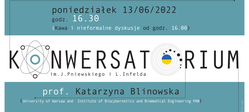
Wykład otwarty
Information Transfer between Brain Structures in Norm and Pathology
prof. Katarzyna Cieślak-Blinowska
Konwersatorium im. Jerzego Pniewskiego i Leopolda Infelda FUW
13 czerwca 2022 16:30
ul. Pasteura 5, transmisja online
Serdecznie zapraszamy na ostatnie w tym roku akademickim Konwersatorium im. Jerzego Pniewskiego i Leopolda Infelda Wydziału Fizyki UW, które odbędzie się 13 czerwca o godz. 16:30 w tradycyjnej formie w sali 0.03 Wydziału Fizyki. Spotkanie będzie także transmitowane przez Internet.
Naszym gościem będzie:
prof. Katarzyna Cieślak-Blinowska,
Uniwersytet Warszawski i Instytut Biocybernetyki i Inżynierii Biomedycznej, PAN
która wygłosi wykład:
"Information Transfer between Brain Structures in Norm and Pathology".
Prof. Katarzyna Cieślak-Blinowska, której uroczyste odnowienie doktoratu miało miejsce 20 kwietnia 2022 roku, w swej pracy badawczej zajmuje się działaniem ludzkiego mózgu. Stworzyła ona m. in. metodę Kierunkowej Funkcji Przejścia (Directed Transfer Function), która służy do określania kierunkowej transmisji czynności elektrycznej mózgu. Metoda ta stała się podstawowym i powszechnie używanym narzędziem w badaniach nad mózgiem w oparciu o sygnał EEG. Podczas wykładu będziemy mogli, uzyskując informacje "z pierwszej ręki", dowiedzieć się o działaniu i zastosowaniu Kierunkowej Funkcji Przejścia w badaniach oddziaływań między strukturami w mózgu człowieka.
Przed konwersatorium, od godz. 16:00, zapraszamy na nieformalne dyskusje przy kawie i ciastkach w holu przed salą 0.03.
Z pozdrowieniami,
Barbara Badełek
Jan Chwedeńczuk
Jan Kalinowski
Jan Suffczyński
prof. Katarzyna Cieslak-Blinowska,
University of Warsaw and Institute of Biocybernetics and Biomedical Engineering, PAN
"Information Transfer between Brain Structures in Norm and Pathology"
The evaluation of interactions between brain structures plays a central role in understanding normal and pathological brain function. At present, a large bulk of evidence concerning the localization of active areas in the brain is available due to neuroimaging methods. However, much less is known about interactions between them. The connectivity patterns in the brain may be determined by means of electroencephalographic (EEG) activity analysis, providing that adequate signal processing methods are applied. The most appropriate methods involve multivariate autoregressive measures and, among
them, Directed Transfer Function (DTF). Based on the Granger causality principle, this measure exposes directed relations between brain structures as a function of frequency, is robust in respect to noise, mitigates volume conduction, can identify reciprocal interactions, and is free from the common
drive effect. Contrary to popular bivariate methods (e.g., correlation or coherence), which are biased by spurious connections, it yields sparse, clear-cut functional connectivity patterns. In its time-varying form, DTF reveals dynamical interactions between brain structures. The application of DTF to motor and cognitive tasks and to the assessment of pathological brain states will be presented. Moreover, the suitability of DTF for the analysis of signals of different origins will be shown.

